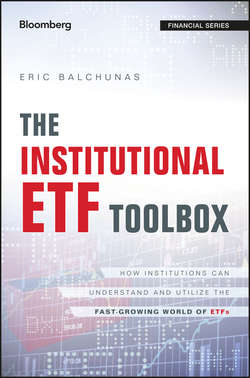Читать книгу The Institutional ETF Toolbox - Balchunas Eric - Страница 21
На сайте Литреса книга снята с продажи.
SECTION I
The ETF Phenomenon
CHAPTER 1
Why Are ETFs So Popular?
Price Discovery
ОглавлениеIf you want to know what the market really thinks about something, just look at where the ETF is trading. This real-time information can be useful both in normal market environments and on days of intense market stress. ETFs are the tip of the spear in terms of trying to figure out how a market is valuing something. They rival the futures market in this aspect.
For example, many international ETFs trade while the markets they track are closed. Suppose news in the United States of new Russian sanctions comes out at 2 P.M. EST. Russian ETFs will trade immediately on that news and inform investors as to what the underlying Russian stocks are worth and where they may open. This also applies to less liquid areas of fixed income as well.
“ETFs in many ways offer opportunities in price discovery in fixed income. Very much the same way when you trade Japan or Germany equity ETFs. When those markets close, that doesn’t mean there isn’t a value or people stop thinking about the situation.”
Linda Zhang, Windhaven Investment Management
Day-to-day, ETFs are slowly starting to replace indexes as the proxies for different markets as well. And why not? Unlike an index, you can actually invest in the ETF.
Beyond the day-to-day, there have been some extreme examples where the ETF served as a discovery tool in market-moving events when markets were closed or incredibly stressed.
One example is after the terrorist attacks of 9/11 and SPY. All trading of stock and bonds was halted from 9/11 through 9/17. When trading opened at 9:30 A.M. on 9/17, SPY began trading immediately and effectively, even though some of the stocks in the S&P 500 had not yet begun trading. Because of this, investors were able to use SPY as a price discovery vehicle and make implied valuations on those stocks that not yet begun trading.
Another example is when Egypt’s stock market closed for two months between January and March 2011 due to violent protests in the country. The Market Vectors Egypt ETF (EGPT) continued to trade and serve as a guide as to where the market was trading. Many used the ETF to trade Egypt as volume on the ETF more than tripled during the time – all the while, investors holding individual Egyptian stocks were locked up entirely. They had no venue to unload or acquire those shares. Not surprisingly, the ETF deviated from the net asset value (NAV) and traded at a premium (price goes above its NAV) because the underlying stocks had no updated prices to feed into the NAV calculation. Additionally, creations and redemptions could not be done due to the stock market being closed, as shown in Figure 1.5. We will explore creations and redemptions more in Chapter 3 and premiums in Chapter 5.
Figure 1.5 EGPT’s Price and NAV Graph with Flows at Bottom
Source: Bloomberg
The most recent example was in Greece, where the stock market closed for a few weeks in July as the country was in a debt crisis. Meanwhile, the Global X FTSE Greece 20 ETF (GREK) continued to trade about triple its average volume. When it finally came down, it was very close to what the stocks were priced at when they opened.
The idea that you can invest in, trade or simply monitor an ETF even though the markets the ETF tracks are experiencing issues, can be helpful in terms of pricing and portfolio management.
